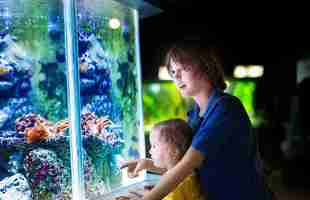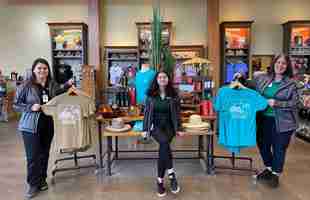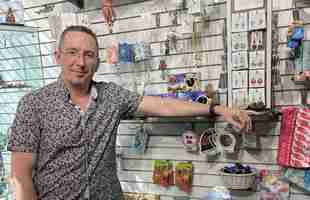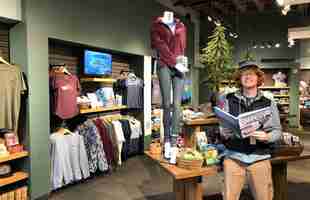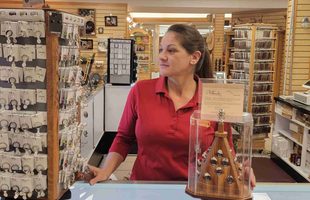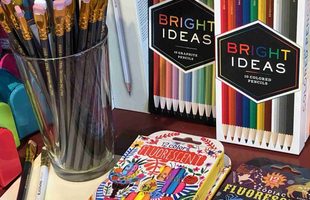By Karen Appold
When looking to boost souvenir sales, Samantha Halligan, assistant director of guest services, Lake Superior Zoo, Duluth, Minn., has found that one of the simplest things you can do is to keep displays fresh. “Whether you change them as a result of a new season or holiday, or because of new products or new exhibits, keeping displays unique, exciting, eye-catching and up to date can drive customer focus and souvenir sales.”
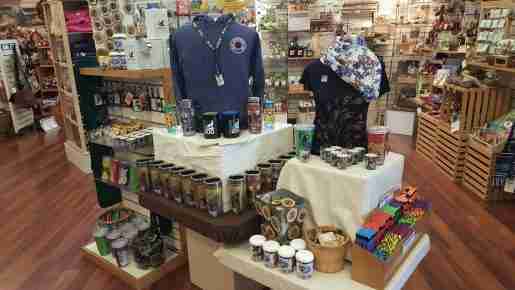 Merchandise at the Lake Superior Zoo in Duluth, Minn. Displays that are well lit and strategically placed are more likely to attract shoppers.
Merchandise at the Lake Superior Zoo in Duluth, Minn. Displays that are well lit and strategically placed are more likely to attract shoppers.The location of items can also increase souvenir sales. “Displays that are front and center and near counters, and displays that are under brighter lighting are more likely to attract buyers,” Halligan said.
Alexandra Myers, supervisor of Jekyll Island Museum Gift Shop, Jekyll Island, Ga., advised thinking about geometric shapes and symmetry when creating displays. “Displays need variety in height and depth,” she said. “Consider the fact that people usually don’t paint or purchase a painting of a plain valley. They will, however, buy a painting of a valley with a mountain, the sun and a river. These varying geometric shapes make the painting much more appealing. This is what we do with our displays. We emphasize depth with tall items in the back, and smaller items of different shapes toward the front.”
Also, even if a display is beautiful, do not be afraid to change it. “Every time I change a display a co-worker will undoubtedly come in and say, ‘Oh, this is new! I like this!’ when in fact it is an item we’ve had for a while,” Myers said. The 650-square-foot shop garners $280,000 annually.
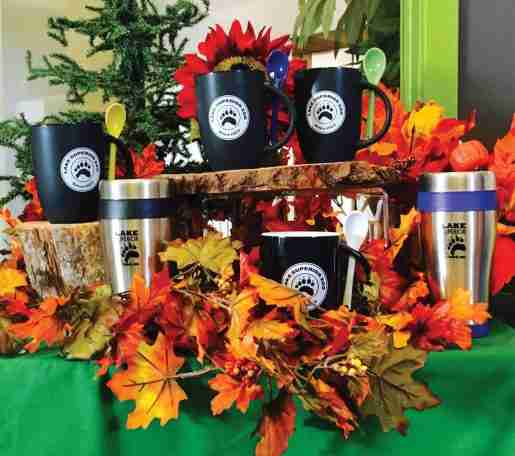 The seasons, holidays and new merchandise are all good reasons to change a display, according to an official with the Lake Superior Zoo.
The seasons, holidays and new merchandise are all good reasons to change a display, according to an official with the Lake Superior Zoo.Karen Waialae, director of retail, Oglebay Resort/Good Zoo, Wheeling, W.V., said grouping merchandise together in a theme such as red pandas, meerkats and so forth works well. “Most customers are interested in one specific animal at the zoo, so it is easier to go to this section,” she said. “We make displays dimensional with different-sized products.”
Because the gift shop at Washington Park Zoo, Michigan City, Ind., is only 800 square feet, Shawne Sheldon, retail manager, tries to use space wisely by filling it with lots to look at but at the same time making sure displays aren’t too overwhelming. “I designate certain areas for different types of merchandise—we have a wall of jewelry, one of snake plush and another of toys, on top of putting plush in every spot we can manage,” she said. “I think that draws people to certain areas and they can find whatever they are looking for a little easier.”
Kimberly Miller, retail manager/buyer, St. Augustine Alligator Farm, St. Augustine, Fla., is a proponent of creating displays that feature a certain animal with a variety of merchandise options such as figurines, coffee mugs, picture frames and salt and pepper shakers.
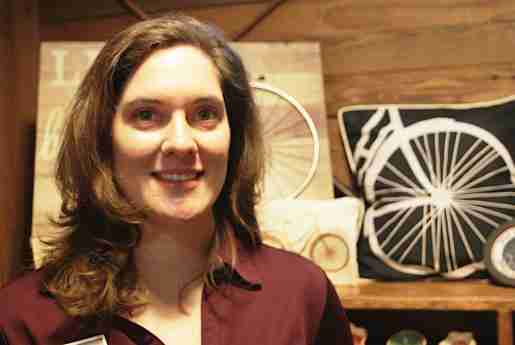 Alexandra Myers, supervisor of the Jekyll Island Museum Gift Shop, Jekyll Island, Ga. Myers advised thinking about geometric shapes and symmetry when creating displays. Photo by Jerod Myers.
Alexandra Myers, supervisor of the Jekyll Island Museum Gift Shop, Jekyll Island, Ga. Myers advised thinking about geometric shapes and symmetry when creating displays. Photo by Jerod Myers.Appealing to Your Demographic
At the zoo gift shop, Halligan has found that customers span a wide demographic. Therefore, the shop carries a wide variety of souvenirs. Drinkware is a great example of how the store offers something for everyone. It sells water bottles, shot glasses, sippy cups, coffee mugs and pint glasses.
Miller’s store also has a broad demographic. Therefore, “We carry everything from plush toys for the kids to wallets and knives for dad,” she said. “We stay on top of seasonal trends by attending several gift shows throughout the year. We customize as much as possible by putting our logo on mugs, key rings, T-shirts and more.”
Visitors to the 1,600-square-foot gift shop at Oglebay Resort/Good Zoo are drawn to merchandise that reflects the zoo’s animals as well as train merchandise—because the zoo has a train. “We have a photographer who makes custom merchandise,” Waialae said. “He takes pictures of the zoo’s animals and then produces magnets, cups, T-shirts, key chains and even a calendar featuring the zoo’s animals.”
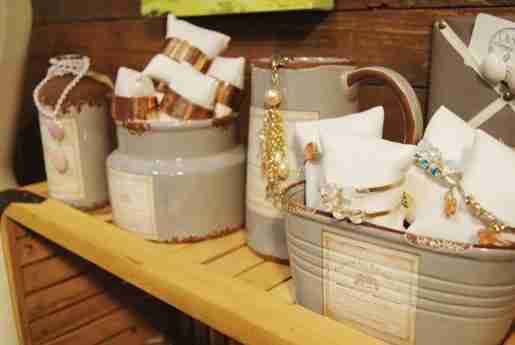 The supervisor at the Jekyll Island Museum Gift Shop advised changing displays, even if an arrangement seems too beautiful to dismantle. Photo by Jerod Myers.
The supervisor at the Jekyll Island Museum Gift Shop advised changing displays, even if an arrangement seems too beautiful to dismantle. Photo by Jerod Myers.Sheldon said merchandise featuring tigers and wolves always sells well—such as plush, T-shirts, magnets and mugs. “Because a lot of our business is school groups, I pick items that they will be able to afford,” she added.
If she is unsure about stocking a new product, Myers will only purchase the minimum quantity the company allows. “This way I am not taking as much of a risk and if the item is a hit I can always order more,” she said.
Connecting with Customers
Myers prefers to think of customers as guests, and strives to ensure that they feel like a guest would when visiting her own home. “Sales associates are here to serve and assist guests with their needs,” she said. “Guests should never feel intimidated or pressured. We are looking to make friends with everyone that enters our humble abode even if they do not purchase anything.”
Another customer service component is playing music ranging from the 1940s to the 1960s. “It’s a wonderful backdrop to the shopping experience,” Myers said. “Before we had music, the store was so quiet. Guests wouldn’t linger as long in the aisles. Now they bounce to a tune or even sing along!”
For Halligan, exceptional customer service includes being engaging, personable, relatable, suggestive and affirmative. “We greet customers with a smile, connect with our visitors on a personal level, share memories that relate to their experiences and use suggestive selling to find the product that connects them to their visit,” she said. “This can be as simple as connecting an experience to an animal and pointing out a souvenir that represents the memories they created during their visit.”
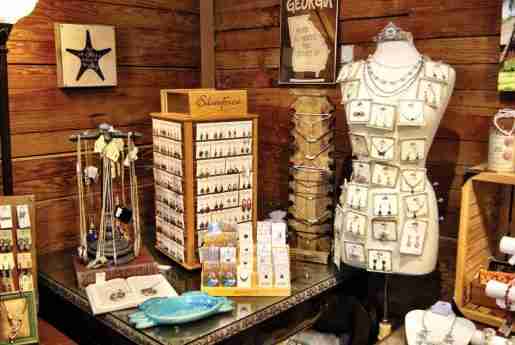 At the Jekyll Island Museum Gift Shop, the store staff uses items of different shapes and heights when designing displays. Photo by Jerod Myers.
At the Jekyll Island Museum Gift Shop, the store staff uses items of different shapes and heights when designing displays. Photo by Jerod Myers.Waialae said gift shop staff need to have great communication skills. “They interact with our guests and provide information and suggestions,” she said. “Most customers are interested in the zoo’s history and information about special featured animals. This year we had several; most customers were not familiar with the breeds.”
Regarding customer service, Sheldon says it’s important to be friendly and approachable. “Gift shop customers often have questions about the zoo,” Sheldon said. “If you take time to interact with them a little, they are more likely to spend time in the gift shop and purchase items.”
Another strategy is if someone is purchasing a tiger plush, for example, then suggest a magnet or mug to go with it. “Visitors often have a favorite animal and they like to see all of the items that you sell featuring that animal,” she said.
The staff at the 1,800-square-foot gift shop at St. Augustine Alligator Farm will ask customers if they are finding everything OK and lets them know that they are there if they need help. “Sometimes just an encouraging word of advice is helpful,” Miller said. “Complimenting their selection and finding something to break the ice and start the interaction is helpful.”
Best-Selling Souvenirs
Top sellers at Jekyll Island Museum Gift Shop include vintage jewelry, books on local history and scarves. “These items do well because they are not readily available in mainstream department stores,” Myers said. “Because we are the gift shop for the museum, we have marketed our store with a 1920s meets 2017 vibe. Our vintage jewelry is fun, flashy and available at a great price. Our books on local history range from college level history to quick tidbits of information. Our scarf sales are boosted by tour bus traffic—because it can get cold on buses.”
At the 900-square-foot gift shop at Lake Superior Zoo, the best-selling souvenirs tend to be products that feature images of its own animals or products whose proceeds contribute to conservation projects. “Buyers can relate to these items on a personal level and it gives them a deeper satisfaction when their purchase helps to fund a greater cause,” Halligan said.
Top sellers at Oglebay Resort/Good Zoo include plush, magnets, cups and T-shirts that are custom made and feature the zoo’s animals. “Price point merchandise is important for families with multiple children who are looking to stay within a budget,” Waialae said. “Plush that reflects the animals in the zoo is definitely number one.”
For Sheldon, plush is the top-selling souvenir. “Kids flock to plush because it is a miniature version of the animal they loved and they feel like they are taking that animal home with them,” she said. For adults, home décor figurines and magnets are hot.
St. Augustine Alligator Farm’s best-selling souvenirs are Scandical Street Signs with names, shot glasses and postcards. “The street signs are a hit with parents and grandparents because the signs contain a collage of some of the park’s animals, the child’s name and our logo,” Miller said. “Shot glasses are always a hit because a lot of people collect them. They range from the simple clear shot with our logo to a really cool shot with an alligator attached to the side. Postcards are a vacation staple. At 25 cents each or five for $1, it a great inexpensive item that we sell thousands of.”
